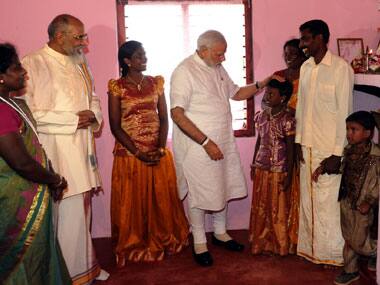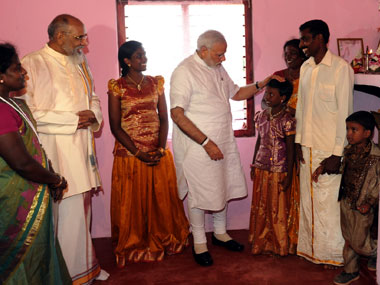Jaffna: The Jaffna leg of Prime Minister Narendra Modi’s just-concluded Sri Lanka visit can be summed up in one sentence. It was a triumph of diplomacy of symbolism over diplomacy of rhetoric. Though many prominent Indians like Mahatma Gandhi and Jawaharlal Nehru had visited Jaffna in the pre-independence era, this was the first time when a sitting Indian Prime Minister visited Jaffna in the post-independence era. Modi’s predecessor Manmohan Singh had several chances to visit Colombo to attend the CHOGM (Commonwealth Heads of Governments Meeting) and take a trip to Jaffna as well in November 2013. Everything was planned for his probable Jaffna visit, including the inauguration of the housing project, from the point of view of the Indian Tamils. But Manmohan Singh chose not to go. He was weighed down by the Tamil Nadu politics even though the mercurial DMK was not an ally of his UPA government then. [caption id=“attachment_2161793” align=“alignleft” width=“380”]
 Modi at the Handing over of homes, at Ilavalai North-West Housing Project site, in Jaffna. PIB[/caption] In contrast, Modi had no such coalition compulsions and was unfazed by Tamil politics because of his overwhelming majority in Lok Sabha without any Tamil party. Thus Modi made hay and went ahead with his Sri Lanka visit with a trip to Jaffna included in his itinerary. His Jaffna visit was a defining moment in Indian political history and a trailblazer in many ways. He went to Jaffna only after catering to three major religious segments of Sri Lanka: the Sinhalase, the Buddhists and the Tamils. He had catered to the Sinhala sentiment during the Colombo leg of his Sri Lanka visit and had interacted closely with the Sinhala-led government of President Maithripala Sirisena. He catered to Sri Lanka’s Buddhist community by visiting Anuradhapura, the Buddhist dominated city. Before that he had participated in the “daana” ritual of Buddhists by feeding the Buddhist monks. So, when he landed in Jaffna, the former stronghold of the Liberation Tigers of Tamil Eelam (LTTE) and the defecto capital of the LTTE for decades, Modi had already taken care of all major Sri Lankan communities. This was the diplomacy of symbolism. In contrast, in Jaffna when he attended his last public function of inaugurating India’s flagship $270 million housing project, involving fifty thousand dwelling units for the affected Tamil population ravaged by the civil war, he was pursuing this diplomacy of symbolism to the hilt. On the other hand, Jaffna chief minister CV Wigneswaran, a political rival of President Sirisena, played the diplomacy of rhetoric. Significantly, PM Modi steered clear of this brand of politics of Wigneswaran. Sample the following remarks of Wigneswaran which he made during the housing project inauguration public function with Modi on the dais. Wigneswaran said the India-Sri Lanka peace accord of 1987 was inadequate to guarantee rights of Lankan Tamils and demanded fresh trilateral talks, involving Sri Lanka, India and the provincial councils of the northern and eastern provinces where most Tamils in Sri Lanka reside. He rubbished the 13th amendment and said Sri Lanka needed to go much beyond that. He thundered thus: “The 13th amendment can never be the final solution.” The 13th amendment to the Sri Lankan Constitution was introduced as a by-product of the 1987 accord inked between the then principals: Indian Prime Minister Rajiv Gandhi and Sri Lankan President J.R. Jayawardene. “May I suggest that there be talks between the Sri Lankan government, Indian government, NPC and the EPC… We need you as a guarantor of our rights,” Wigneswaran said. His remark was addressed more to PM Modi rather than the local audience. Wigneswaran had gone on an over drive. Perhaps it was also a bid to chew more than he could eat as he knew very well that whichever government comes into power in Colombo the implementation of the 13th amendment is easier said than done. In other words, all talk about the 13th amendment is rhetoric given the political ground situation in Sri Lanka. It is a given that no government in Colombo can brook trilateral talks in determining the fate of Sri Lankan Tamils. Modi knew that he was being invited to wade into the cesspool of Sri Lankan politics. But he steered clear from all this. When Modi spoke after Wigneswaran he ignored the chief minister’s rhetoric about the 13th amendment. That is Modi’s personal victory. Manmohan Singh too could have followed the same template nearly one and a half years earlier if only he had cared to travel to Colombo and Jaffna. But he did not. In this context, Modi has lent a much necessary correction to India’s Sri Lankan policy. The writer, First Post Consulting Editor, was in Jaffna. He tweets @Kishkindha.
Modi at the Handing over of homes, at Ilavalai North-West Housing Project site, in Jaffna. PIB[/caption] In contrast, Modi had no such coalition compulsions and was unfazed by Tamil politics because of his overwhelming majority in Lok Sabha without any Tamil party. Thus Modi made hay and went ahead with his Sri Lanka visit with a trip to Jaffna included in his itinerary. His Jaffna visit was a defining moment in Indian political history and a trailblazer in many ways. He went to Jaffna only after catering to three major religious segments of Sri Lanka: the Sinhalase, the Buddhists and the Tamils. He had catered to the Sinhala sentiment during the Colombo leg of his Sri Lanka visit and had interacted closely with the Sinhala-led government of President Maithripala Sirisena. He catered to Sri Lanka’s Buddhist community by visiting Anuradhapura, the Buddhist dominated city. Before that he had participated in the “daana” ritual of Buddhists by feeding the Buddhist monks. So, when he landed in Jaffna, the former stronghold of the Liberation Tigers of Tamil Eelam (LTTE) and the defecto capital of the LTTE for decades, Modi had already taken care of all major Sri Lankan communities. This was the diplomacy of symbolism. In contrast, in Jaffna when he attended his last public function of inaugurating India’s flagship $270 million housing project, involving fifty thousand dwelling units for the affected Tamil population ravaged by the civil war, he was pursuing this diplomacy of symbolism to the hilt. On the other hand, Jaffna chief minister CV Wigneswaran, a political rival of President Sirisena, played the diplomacy of rhetoric. Significantly, PM Modi steered clear of this brand of politics of Wigneswaran. Sample the following remarks of Wigneswaran which he made during the housing project inauguration public function with Modi on the dais. Wigneswaran said the India-Sri Lanka peace accord of 1987 was inadequate to guarantee rights of Lankan Tamils and demanded fresh trilateral talks, involving Sri Lanka, India and the provincial councils of the northern and eastern provinces where most Tamils in Sri Lanka reside. He rubbished the 13th amendment and said Sri Lanka needed to go much beyond that. He thundered thus: “The 13th amendment can never be the final solution.” The 13th amendment to the Sri Lankan Constitution was introduced as a by-product of the 1987 accord inked between the then principals: Indian Prime Minister Rajiv Gandhi and Sri Lankan President J.R. Jayawardene. “May I suggest that there be talks between the Sri Lankan government, Indian government, NPC and the EPC… We need you as a guarantor of our rights,” Wigneswaran said. His remark was addressed more to PM Modi rather than the local audience. Wigneswaran had gone on an over drive. Perhaps it was also a bid to chew more than he could eat as he knew very well that whichever government comes into power in Colombo the implementation of the 13th amendment is easier said than done. In other words, all talk about the 13th amendment is rhetoric given the political ground situation in Sri Lanka. It is a given that no government in Colombo can brook trilateral talks in determining the fate of Sri Lankan Tamils. Modi knew that he was being invited to wade into the cesspool of Sri Lankan politics. But he steered clear from all this. When Modi spoke after Wigneswaran he ignored the chief minister’s rhetoric about the 13th amendment. That is Modi’s personal victory. Manmohan Singh too could have followed the same template nearly one and a half years earlier if only he had cared to travel to Colombo and Jaffna. But he did not. In this context, Modi has lent a much necessary correction to India’s Sri Lankan policy. The writer, First Post Consulting Editor, was in Jaffna. He tweets @Kishkindha.
Consulting Editor, Firstpost. Strategic analyst. Political commentator. Twitter handle @Kishkindha.
)